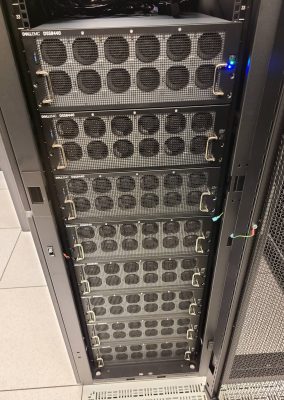Do you need more computing power to move your work forward? Since 2011, the Research Computing team within Information Technology Services (ITS) has helped faculty and staff tackle computational challenges beyond the capabilities of a normal desktop or laptop computer.
Each semester, ITS hosts the Research Computing Series to help students, faculty and staff understand how they can leverage Syracuse University’s advanced computing resources. This semester, the Research Computing Series will take place virtually over two sessions:
- On April 19, Shane Sanders and Justin Ehrlich from the Falk College of Sport and Human Dynamics will discuss some of their work in the R programming language that required extra resources beyond desktop machines.
- On April 28, the ITS Research Computing team will provide an overview of available research computing resources and how faculty members can get started.
Chief Technology Officer Eric Sedore recently participated in a brief Q&A as the Research Computing team approaches its 10th anniversary and prepares for this semester’s sessions.
“Everything rolls up to expanding the reach and impact of Syracuse University nationally and internationally…”
What is the Research Computing team’s mission? Why was it created?
 The Research Computing team originally launched in 2011 to address a gap: There were no central research computing resources or capabilities to help faculty members who needed something beyond their desktop computer or what was available in their lab. ITS utilized and combined some existing resources, such as OrangeGrid, which securely scavenged compute time from idle desktops, and the Academic Virtual Hosting Environment from an existing investment in disaster recovery, to provide campus researchers something that could assist with challenging and compute-intense academic work.
The Research Computing team originally launched in 2011 to address a gap: There were no central research computing resources or capabilities to help faculty members who needed something beyond their desktop computer or what was available in their lab. ITS utilized and combined some existing resources, such as OrangeGrid, which securely scavenged compute time from idle desktops, and the Academic Virtual Hosting Environment from an existing investment in disaster recovery, to provide campus researchers something that could assist with challenging and compute-intense academic work.
What makes a researcher or a project a good candidate for working with your team?
We are happy to explore ways we can help with any project that needs resources beyond what is readily available to the researchers. We will work with anyone in the University community, whether it’s related to research or teaching and learning. Although historically we’ve worked a lot with STEM projects, we collaborate with all academic areas—we have great relationships with faculty across a variety of fields.
What are some key successes that the Research Computing team worked on?
We’ve been very proud to help some really remarkable researchers. We’ve provided support for a wide range of academic work, including research as well as teaching and learning. One thing that stands out is our involvement with [Arts and Sciences Physics Professor] Duncan Brown’s research, which contributed to the confirmation of the existence of gravitational waves. We also have helped secure three grants from the National Science Foundation (NSF) to support computational needs on campus.
How have research computing needs on campus changed over time? Specifically, what changes have you noticed during the pandemic?
From its inception, research computing on campus has constantly evolved to offer a portfolio of services to meet the diverse needs of the campus community. These services include high-throughput computing, high-performance computing, high-speed networking and most recently an NSF augmented GPU cluster. In addition to local capabilities, the team has built connections to allow for utilizing the public cloud and collaborated with other institutions across the nation to provide access to federated compute resources.
During the pandemic, requests for resources and assistance increased notably. From what we observed, researchers were transitioning time from their on-campus labs to computational projects. The community readily adapted to virtual meetings for interactions with us, which helped in terms of onboarding and exploring complicated issues.
What are your goals for the future of research computing on campus?
We want to continue to provide a relevant set of resources for all academic areas, including cloud-based options. In terms of support, we want to move toward more proactive interactions with our community. Ultimately, everything rolls up to expanding the reach and impact of Syracuse University nationally and internationally, both for assisting existing researchers as well as attracting top-tier students and faculty.
